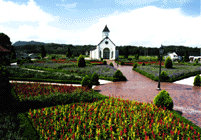
Herbs have grown rapidly in popularity in Japan over the past few years. A large number of specialty shops have opened, and products have diversified from cooking ingredients, which have a long history, to perfumes, cosmetics, and bath tonics. Business sources predict a rosy future, with a market of 100 billion yen lying not far around the corner. The popularity of herbs, like Japan's health food boom, is considered to be one manifestation of a "back to nature" orientation that has recently taken hold among many Japanese.
When they think of herbs, Japanese generally think of European inland plants that are recognized by alternative or traditional forms of medical treatment to have pharmaceutical effects. In some parts of Europe there are herbs that are recognized as pharmaceutical drugs. In Japan, however, as long as herbs are not given official recognition as pharmaceutical drugs, they cannot be treated as medical goods. At the time of sale, therefore, it is a violation of the Pharmaceutical Law to use any expression suggesting that the herb has any kind of medicinal properties.
Nevertheless, herb-related products that are sold over the counter in Japan frequently carry descriptions claiming a kind of medicinal effect. Chamomile, for example, is said to have the effect of relaxing the body; lavender is said to be effective in treating liver ailments.
According to business sources, there are 400,000-500,000 herb fans around the country. More than 90% of them are women, mainly in their thirties but also spanning various age groups from the twenties to the fifties. The secret of herb popularity, apparently, is that herbs have a wide variety of uses, ranging from scents to bath tonics and crafts, and they possess a certain image as a cultural status symbol.
At present there are as many as 300 special herb shops in Japan, and florists, cosmetic stores, department stores, and others also handle herbs. In addition, herb-related recreational facilities have appeared on the scene recently, such as herb gardens and herb lodges. This new phenomenon of herb-related recreation, which has become especially popular among women, consists of taking a stroll in a garden full of herbs, refreshing yourself in a herb-scented shower, enjoying a meal of herb dishes and herb tea, spending the night in a lodge on the premises, and in the morning purchasing herb products, such as young plants, seeds, and potpourris, to take home as souvenirs.
Thanks to the herb boom, the number of herb-related businesses in Japan comes to no less than 2,000, with new entrants springing up all the time, and annual sales of herb-related products are said to reach from 70 billion to 80 billion yen.
The popularity of herbs in Japan has brought about a rapid increase in imports. It is said, for example, that the production of 1 cubic centimeter of lavender essence requires several dozen kilograms of flower. Since domestic production cannot possibly meet the demand in Japan, Japan has to depend on imports. The import of dried herbs more than doubled from 500 tons in 1990 (30 billion yen) to 1,100 tons in 1994 (60 billion yen).
(The above article, edited by Japan Echo Inc., is based on domestic
Japanese news sources. It is offered for reference purposes and does not
necessarily represent the policy or views of the Japanese Government.)